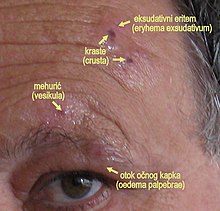User:Mr. Ibrahem/Herpes zoster ophthalmicus
| Herpes zoster ophthalmicus | |
|---|---|
| Other names | Ophthalmic zoster |
 | |
| Herpes zoster ophthalmicus | |
| Specialty | Ophthalmology |
| Symptoms | Rash of the forehead, swelling of the eyelid, pain and red eye[1] |
| Complications | Vision loss, chronic pain[2] |
| Causes | Reactivation of varicella zoster virus[2] |
| Risk factors | Poor immune function, psychological stress, older age[2] |
| Diagnostic method | Based on symptoms[1] |
| Prevention | Herpes zoster vaccine[1] |
| Medication | Antiviral pills such as acyclovir, steroid eye drops[1] |
| Frequency | Up to 125,000 per year (US)[3] |
Herpes zoster ophthalmicus (HZO), also known as ophthalmic zoster, is shingles involving the eye.[1] Symptoms generally include a rash of the forehead with swelling of the eyelid.[1] There may also be eye pain, eye redness, and light sensitivity.[1] Before the rash appears tingling may occur in the forehead along with a fever.[1][3] Complications may include vision loss, increased pressure within the eye, and chronic pain.[2][1]
The underlying mechanism involves a reactivation of the varicella zoster virus within the ophthalmic nerve (the first division of the trigeminal nerve).[2] Risk factors include poor immune function, psychological stress, and older age.[2] Diagnosis is generally based on symptoms.[1]
Treatment is generally with antiviral pills such as acyclovir.[1] Steroid eye-drops and drops to dilate the pupil may also be used.[1] The herpes zoster vaccine is recommended for prevention in those over the age of 50.[1] Shingles affects up to half a million people in the United States a year of which 10% to 25% involve the eye.[3][2]
References[edit]
- ^ a b c d e f g h i j k l m "Herpes Zoster Ophthalmicus - Eye Disorders". Merck Manuals Professional Edition. Retrieved 21 December 2019.
- ^ a b c d e f g Shaikh S, Ta CN (November 2002). "Evaluation and management of herpes zoster ophthalmicus". American Family Physician. 66 (9): 1723–30. PMID 12449270.
- ^ a b c "Herpetic Corneal Infections: Herpes Zoster Ophthalmicus". www.aao.org. Retrieved 21 December 2019.
